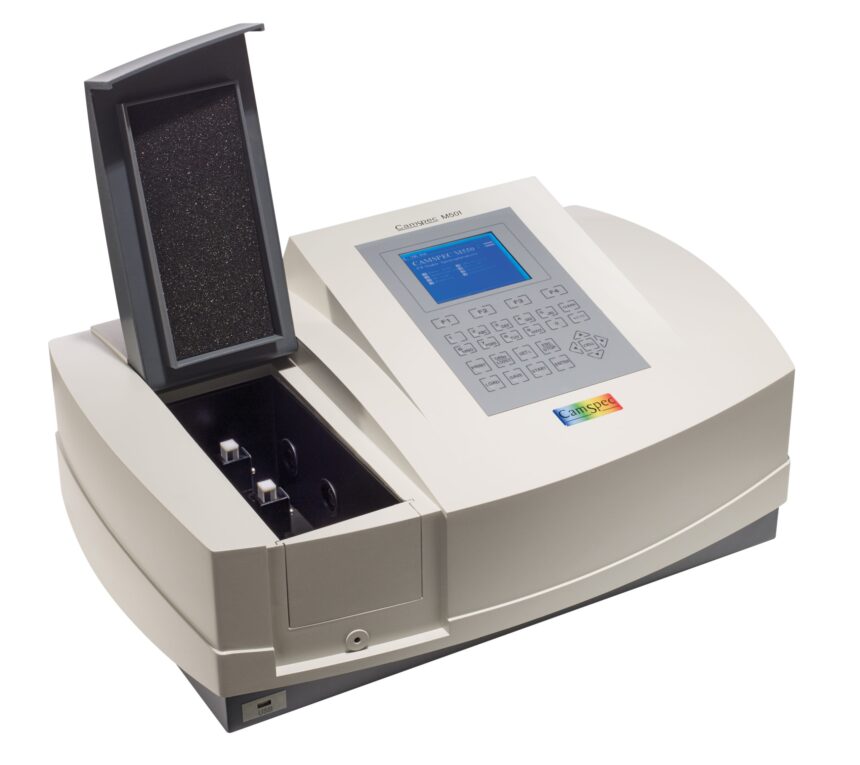What is Spectrophotometer?
A spectrophotometer is an instrument that measures how much light is absorbed by a sample, or in other words, how much light passes through that sample. It employs the use of spectroscopy to measure either a spectrum of light or a portion of that spectrum that is absorbed or emitted by a sample. The principle behind spectrophotometers is that different chemicals and molecules absorb different wavelengths of light. By measuring the light absorbed at various wavelengths, a spectrophotometer can determine the chemicals present or quantify the amounts of those chemicals.
Types of Spectrophotometers
There are different types of Spectrophotometers depending on the type of spectroscopy technique used and the wavelength range measured:
UV-Visible Spectrophotometer: Measures absorption in the ultraviolet-visible spectral region, which has wavelengths from about 190 nm to 750 nm. This is the most common type used in laboratories for quantitative analysis of solutions.
Infrared Spectrophotometer: Used to study molecular vibrations and measures absorption in the infrared region from 750 nm to 1 mm. Useful for identifying organic compounds.
Fluorescence Spectrophotometer: Detects fluorescent emissions from samples after they have absorbed light. It uses UV or visible light to excite electrons in fluorescent molecules. Common in chemistry, biology, and biochemistry.
Atomic Absorption Spectrophotometer: Analyzes gases by breaking up samples into atoms with a flame. Useful for trace metal analysis in liquids.
Raman Spectrophotometer: Analyzes molecular vibrations and rotations in a sample using Raman scattering. Can identify unknown compounds.
Components and Operation
A basic spectrophotometer consists of the following key components:
– Light source: Usually a tungsten lamp for visible light or a deuterium arc lamp for UV light. Produces a continuous spectrum of wavelengths.
– Wavelength selector: A diffraction grating, prism, or filter selects the desired wavelength from the light source. Examples include diffraction gratings and monochromators.
– Sample holder: Holds the liquid or solid sample in the path of light. Cuvettes are commonly used for liquid samples.
– Detector: Measures the intensity of light after it passes through the sample. Photodiodes and photomultiplier tubes are common detectors.
– Readout: A computer interface reads and processes the signal from the detector. Molecular structure information or concentration is displayed.
The sample is placed in the sample holder between the light source and detector. Light of a specific wavelength is passed through and its intensity after transmission through the sample is measured by the detector. This process is repeated across a range of wavelengths to obtain an absorption spectrum.
Applications
Spectrophotometers have a wide range of applications across various fields including:
Chemistry: Common analyzes include quantitative determination of solutes, water/wastewater analysis, absorption spectroscopy of organic compounds.
Biology: Used for DNA/RNA quantitation, analysis of enzymes and proteins, hemoglobin testing, and other biochemical assays.
Pharmaceutical: Key tool in quality control testing of drugs and drug products. Allows analysis of active ingredients and impurities.
Forensics: Fingerprint detection, identification of forensic traces like blood, semen, saliva through spectroscopy.
Food and Beverage: Tests for colorants, preservatives, vitamins, lipids, proteins and purity checks. Important in quality control.
Environment: Monitoring of atmospheric and water pollutants, testing of industrial effluents, analysis of soil components.
Advantages and Future Trends
Spectrophotometers provide several key advantages:
– Highly sensitive – Can detect very low concentrations down to parts-per-million.
– Precise quantification – Absorption measurements directly relate to analyte concentration.
– Fast analysis – Automated instruments can analyze multiple samples rapidly.
– Non-destructive – Light-based methods avoid damage to samples.
– Diversity of applications – Optical spectroscopy adapts to various fields and analyzes.
Future trends include miniaturized portable spectrometers, improved optical sensors, coupled separation methods like HPLC, integration with artificial intelligence for automated diagnostics and interpretation of complex spectra. Multidimensional spectroscopy methods could provide additional molecular information beyond conventional spectroscopy. Overall, spectrophotometers will continue evolving to enable accurate chemical analyses across wider applications.
*Note:
1. Source: Coherent Market Insights, Public sources, Desk research
2. We have leveraged AI tools to mine information and compile it
About Author – Priya Pandey
Priya Pandey is a dynamic and passionate editor with over three years of expertise in content editing and proofreading. Holding a bachelor’s degree in biotechnology, Priya has a knack for making the content engaging. Her diverse portfolio includes editing documents across different industries, including food and beverages, information and technology, healthcare, chemical and materials, etc. Priya’s meticulous attention to detail and commitment to excellence make her an invaluable asset in the world of content creation and refinement. LinkedIn Profile


